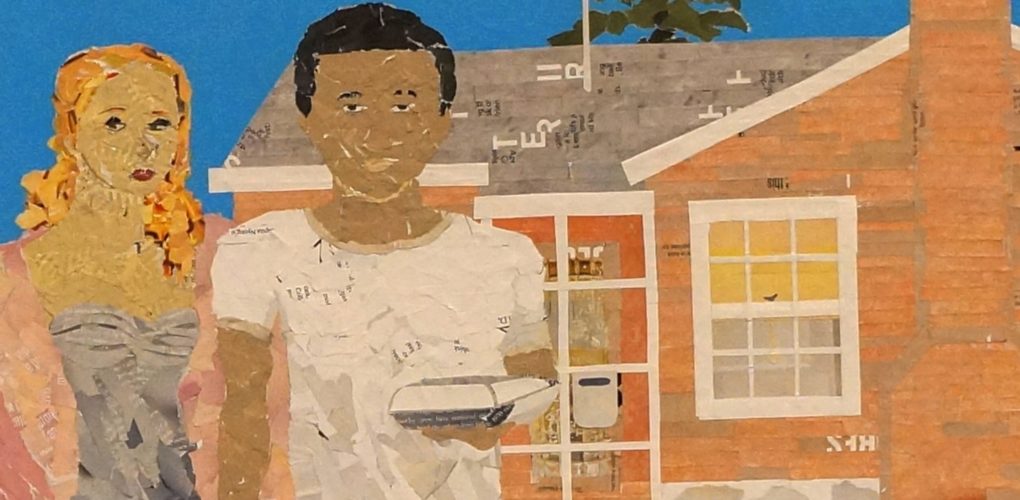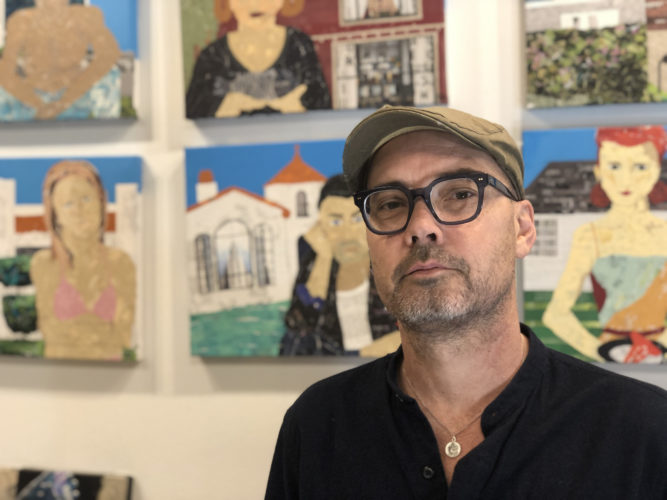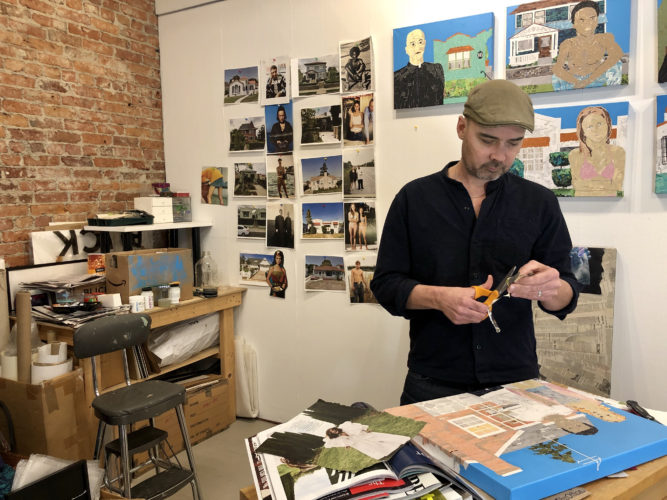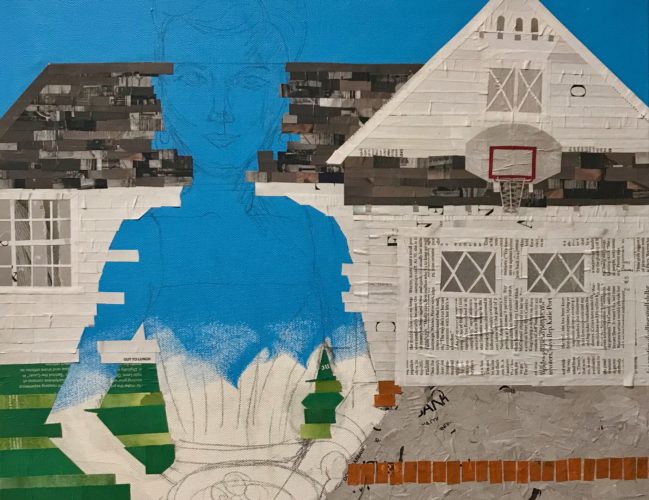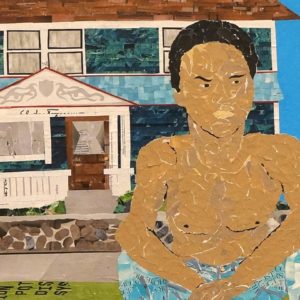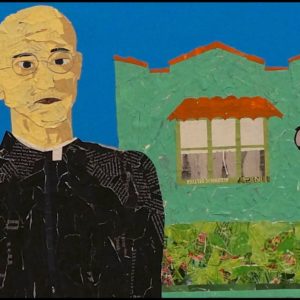The Others
 Meet the Others: Ray Monde
Meet the Others: Ray Monde
The Game Changers. The Rule Breakers. The Innovators. Discover some of the fantastic emerging talent showcasing their work at The Other Art Fair.
Ray Monde‘s latest works are inspired by the streets of Los Angeles and the people who shape the suburbs around them. Created for The Other Art Fair Los Angeles 2020 and now being showcased as part of the Online Studios, they capture the heat and jammed brilliance of the daylight.
All the titles of the works are driven by incredible LA poets including Wanda Coleman, Randall Jarrell, Bertolt Brecht, DJ Waldie, Garrett Hongo and Dana Gioia. Some of the streets and suburbs that influenced these artworks include Sloan Street in Compton; Douglas Street in Angelino Heights; Alonzo Avenue and Zelzah Avenue in Encino; Copa de Oro Road in Bel Air, and North Anita Avenue in Brentwood.
Q&A with the Artist
Tell us about who you are and what you do. What is your background?
I am an Australian-born, Seattle-based contemporary paper artist. As a kid I used to plaster my bedroom with pictures from magazines. Those early days with paper and glue sparked a deep connection with the tactile nature of paper.
My art practice continues to be paper-based. While my early works were carefully cut images from magazines, I moved to creating color palettes of torn colors from glossy magazines. This forces me to economize in color and creates serendipitous moments when part of a printed images becomes something else entirely.
There is an element of destruction and rebirth in my work – destroying the glossy magazines of my former advertising life to create something entirely new. I used to be an advertising creative, working in ad agencies in Sydney, London and New York, then decided to give it away to do what I always really wanted to do – create art.
What are the major themes you pursue in your work?
For me, all my works have to tell a story. There’s a narrative that I’m pursuing when I create a work, but I also love other people’s interpretations of my work. I’m totally intrigued by what they see in what I have created. My works generally have a bright color palette, all my collage uses a broad color panes in the background on which I build up layers of textured paper to create the work.
While the artworks are bright, they often carry a darker story. My works that sold out at The Other Art Fair in Sydney, explored our collective childhood experiences, which aren’t always happy ones. From there, I’ve been exploring the myths of suburban life. I like to call these works suburban gothic, we grow up in suburbs, they nurture us, but for many of us, we can’t wait to escape them. I also like to think of our back yards and balconies as performance stage, where we live out all our hopes and dreams in these small spaces, where all our neighbor’s are unwitting voyeurs. The narrative behind the Streets of Los Angeles series that I’ve most recently put together can be found here.
How did you first get interested in your medium and what draws you to it specifically?
I have always love the tactile nature of paper. I love the weight of it in my hands, I like how the torn edges of paper create random, yet perfect forms shapes for what I’m creating, like the edges of someone’s fringe, or the curve of a dog’s tail. Paper has been part of my life for as long as I can remember, I was always tearing up magazines and sticking them on my walls. As a teenager, I decoupaged everything in my bedroom – tables, chairs, CD racks. Even when I moved into a career in advertising, I started in direct marketing, which is essentially sending paper through the post. Paper is me.
How has your style and practice changed over the years?
When I started creating paper-based works, I would flip endlessly through magazines trying to find the shape or form I was looking for. And I couldn’t create exactly what I had in my mind. That’s when I moved to creating color palettes, tearing up magazine paper into folders of red, yellows, orange, blues, then using these to create the images I had in my mind. What I loved about this was when it created serendipitous moments, when an O that is printed on a page becomes someone’s eye. Recently, my work has shifted again, where I paint over magazine paper with a light wash, so the texture still comes through, but it gives me better control of my color palette.
Can you walk us through your process? How long do you spend on one work? How do you know when it’s finished?
I generally work in a series, in series of ten works, which centre on a very specific theme, for example, the suburban gothic of my current works. Then I’ll draw lots and lots of little thumbnails of what I think the work will look like. These thumbnails are tiny, only about 2 inches square. I think this is a legacy of my advertising career where I would scamp up a concept really quickly to get the idea across. I then paint the base layer of paint and start layering paper onto that to create the artwork. Because I work with paper and binder medium, it gets very sticky, I often have to use needles to pick up small crescents of paper and stick them down. In one of my latest works it took me 5 hours to create a face that was less than 1 inch x 1 inch. I keep going till it looks right. Often I will turn a work to face the wall for a week or so, then turn it back around again to see it with fresh eyes. Often I will add more small details before I think it’s finished.
What series or project are you working on next?
With the coronavirus, I haven’t been able to get into my studio so I have had to change the way I work. I visited the recently-opened Seattle Asian Art Museum before it was closed because of COVID-19. This visit sparked a completely new direction for me in terms of style and narrative.
Seeing three Chinese landscape scrolls at the museum sparked a fire for me in Shan Shui, the traditional Chinese landscape. In the past, I have found these works flat and impenetrable. This time, they triggered an explosion of work, inspired by the Puget Sound and the coronavirus.
These works are a direct and visceral response to the issues and experiences we are all going through – isolation, loneliness, regimentation and a deeper connection with the things we hold true – using the landscape as a platform to tell these stories. The mountains dwarf the people within the landscapes, much like the world events have made our place in the world feel tenuous and small.
I was also lucky to be able to create a mural on the boarded up shopfronts near my studio – it was 56 feet wide and 8 feet tall.
What is the best advice given to you as an artist?
The best piece of advice I got is just to keep going, work, work, work, work, work. You’ve got to do something every day, even if it’s just a sketch, even if what you create is terrible, by working and working and working; you get better, more confident and it triggers new things, new ways to experiment. In fact now, if I’m not creating every day, I can feel the impact on me.
https://www.instagram.com/p/CAeAl5XAewg/
Shop artwork by Ray and other trailblazing artists at The Other Art Fair’s Online Studios.
Introducing The Other Art Fair Online Studios, a new online platform offering art lovers around the world access to over 800 Fair artists. The Online Studios will keep our community feeling inspired, engaged, and continue to spread joy through art.
